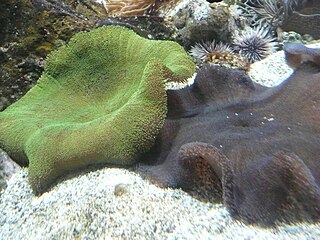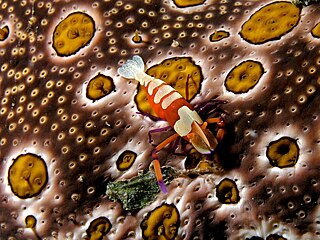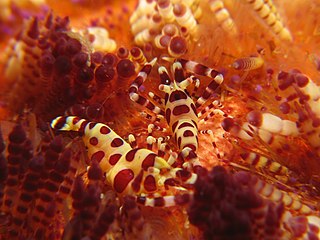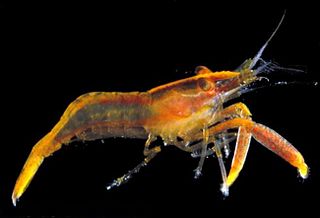
Chappaquiddick Island, a part of the town of Edgartown, Massachusetts, is a small island off the eastern end of Martha's Vineyard. Norton Point, a narrow barrier beach, sometimes connects Martha's Vineyard and Chappaquiddick between Katama and Wasque. Breaches occur due to hurricanes and strong storms separating the islands for periods of time, most recently on December 22, 2022. While both land forms have mostly been connected to one another in modern history, Chappaquiddick is nevertheless referred to as an island.

The spotted cleaner shrimp, is a kind of cleaner shrimp common to the Caribbean Sea. These shrimp live among the tentacles of several species of sea anemones. They sway their body and wave their antennae in order to attract fish from which they eat dead tissue, algae and parasites.

Stichodactyla haddoni, commonly known as Haddon's sea anemone, is a species of sea anemone belonging to the family Stichodactylidae. It is found in the Indo-Pacific area.

Ancylomenes magnificus, also known as the magnificent anemone shrimp, is a species of cleaner shrimp common to the Western Pacific Ocean at depths of 3–29 metres (10–95 ft). They are commonly found on stony coral, Catalaphyllia and the sea anemone, Dofleinia armata.

Periclimenes imperator, known as the emperor shrimp, is a species of shrimp with a wide distribution across the Indo-Pacific. It lives commensally on a number of hosts, including the sea slug Hexabranchus. A. J. Bruce first described it in 1967 based on eight specimens ranging from 4 millimetres (0.16 in) to 7.6 millimetres (0.30 in), and found Periclimenes rex to be its best resemblance.
Periclimenes acanthimerus is a species of shrimp found in New Caledonia. It was first named by Alexander James Bruce in 2006.
Ancylomenes adularans is a species of shrimp. It was first named by A. J. Bruce in 2003 in a journal article entitled "Periclimenes species from far North Queens-land".
Periclimenes dardanicola is a species of shrimp found in the western Pacific Ocean. It lives in association with sea anemones that live on the gastropod shells carried by hermit crabs. It was first named by Alexander J. Bruce and Junji Okuno in 2006. It is mainly white, and grows up to a carapace length of 4 mm (0.16 in).
Erskine Island is a small coral cay in the southern Great Barrier Reef, located 60 kilometres northeast of Gladstone, Queensland and 17 km west-south-west of Heron Island. It is part of the Capricornia Cays National Park and of the Capricornia Cays Important Bird Area.

Ancylomenes is a genus of shrimp, erected in 2010 to accommodate the group of species around "Periclimenes aesopius". Members of the genus are widely distributed in the warm oceans of the world, and live in association with cnidarians; most are cleaner shrimp.

Periclimenes brevicarpalis, the glass anemone shrimp or peacock-tail anemone shrimp, is a species of shrimp belonging to the family Palaemonidae.

Ancylomenes venustus, also known as the graceful anemone shrimp, is a species of shrimp which belongs to the family of the Palaemonidae. This species is found in the tropical waters from the centre of the Indo-Pacific biogeographical area. A. venustus lives in association with scleractinians and actiniarians and is a cleaner shrimp.
Cuapetes lacertae, previously known as Periclimenes lacertae, is a species of shrimp belonging to the family Palaemonidae. Its name is due to the fact the first specimen was collected from Lizard Island: lacerta being Latin for "lizard".
Ancylomenes holthuisi is a species of marine shrimp in the family Palaemonidae. It was first described in 1969 by A.J. Bruce as Periclimenes holthuisi.

Periclimenes colemani is a species of saltwater shrimp found in the Indo-Pacific Ocean that was first described in 1975 by Alexander James Bruce.

Periclimenes, commonly known as glass shrimp or cleaner shrimp, is a commensal and often symbiotic genus of semi-transparent shrimp within the family Palaemonidae. Species of this large genus feature a wide variety of coloration and patterns, widespread distribution throughout much of the world's tropical oceans, and are often sought out for aquarium trade.

The Triton cockatoo is one of the four subspecies of the sulphur-crested cockatoo. The cockatoo was first described by Dutch zoologist, Coenraad Jacob Temminck, in 1849. There is no documentation as to why Temminck selected this name however it is suggested that it was named after the Dutch corvette, Triton, which operated off the Dutch New Guinea coastline, in 19th century.

Periclimenes carinidactylus is a species of saltwater shrimp found in Australian coastal waters and was first described in 1969 by Alexander James Bruce.
Periclimenes exederens is a species of saltwater shrimp in the family, Palaemonidae, and was first described in 1969 by Alexander James Bruce.
Periclimenes mahei is a species of saltwater shrimp in the family, Palaemonidae, and was first described in 1969 by Alexander James Bruce.











